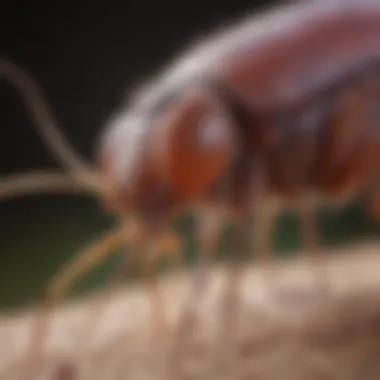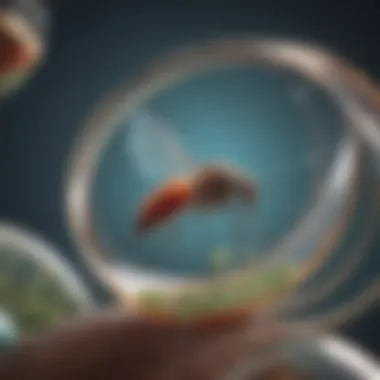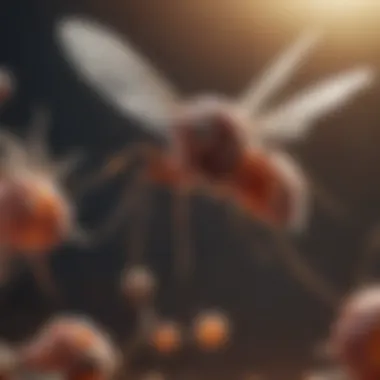Exploring the Challenges of Malaria Vaccine Development


Intro
Malaria continues to pose a significant threat to public health in many regions worldwide. The World Health Organization reported approximately 241 million malaria cases globally in 2020, resulting in about 627,000 deaths. Given these alarming figures, it is understandable that the quest for a malaria vaccine has garnered intense scientific interest. This subject is not just academic; it has real-world implications for millions at risk of this disease.
Overview of Research Topic
Brief Background and Context
The malaria parasite, mainly Plasmodium falciparum, is transmitted through the bites of infected Anopheles mosquitoes. Since ancient times, malaria has shaped human health patterns and demographics. Despite scientific advancements and various control measures, malaria transmission persists in many developing countries. The search for a vaccine began in earnest in the middle of the 20th century, yet despite decades of research, no licensed vaccine has proven effective and suitable for widespread use.
Importance in Current Scientific Landscape
The void of an effective malaria vaccine is a testimony to the challenges inherent in vaccine development. The complexities of the parasite's life cycle, coupled with the host's immune response, present formidable obstacles. Understanding these complexities is crucial not only for the pursuit of a malaria vaccine but also for informing strategies against other infectious diseases. The urgency of this endeavor is starkly illustrated by recent trends in global health, where emerging diseases demonstrate how quickly public health can be threatened.
Challenges Faced in Vaccine Development
Biological Factors Influencing Vaccine Design
The malaria parasite has evolved sophisticated strategies to evade the human immune system. Its life cycle involves multiple stages and different host environments, from the mosquito to the liver and finally to the bloodstream. Each of these phases presents unique targets for immunization but also complicates the design of a vaccine.
- Variation in Antigens: The parasite exhibits a high degree of genetic diversity that leads to variability in surface antigens. This variability complicates the generation of a broadly protective immune response.
- Immune Evasion: The malaria parasite can adjust to the immune systems of its hosts, diminishing the effectiveness of any immunity that might develop through natural infection or vaccination.
Past Research Efforts
Countless efforts have been made to produce an effective malaria vaccine. From the early days of the 1960s with SPf66, to more recent candidates like RTS,S/AS01, many vaccines have entered clinical trials only to fall short in efficacy. These failures highlight the unpredictability of vaccine development and the need for continual innovation in research methodologies.
Current Methodologies in Vaccine Development
Current vaccine research often employs diverse methodologies, including:
- Subunit Vaccines: These include specific proteins from the parasite, aimed at eliciting an immune response without the whole organism's complexity.
- Viral Vector Vaccines: Here, harmless viruses are used to deliver malaria genes to the body, prompting an immune response to malaria without risk of disease.
- mRNA Vaccines: The success of mRNA technology in COVID-19 has spurred consideration for similar approaches in malaria vaccine design.
Future Prospects
Efforts continue to synthesize the advantages of various methodologies. Collaborations among governments, academic institutions, and pharmaceutical companies may foster breakthroughs in vaccine development. The need for an effective malaria vaccine drives innovation, but as history has shown, the path to success is fraught with challenges and uncertainty.
"Despite significant investments and interest in malaria vaccine research, the complexities of the disease continue to challenge our best efforts."
The End
The absence of a malaria vaccine remains a critical issue in global health. Continued research is essential, given the intertwined nature of malaria and socioeconomic development in affected regions. The quest for a malaria vaccine serves as a microcosm for the broader challenges posed by infectious diseases.
Prelims to Malaria
Malaria is a significant global health issue that affects millions of people each year. Its impact is not only felt in health outcomes but also in economic and social dimensions. It is essential to understand malaria in the context of vaccine development for several reasons.
First, malaria transmission remains prevalent in many parts of the world, particularly in sub-Saharan Africa. The disease causes substantial morbidity and mortality. In 2019, there were an estimated 229 million cases of malaria globally, leading to 409,000 deaths. An understanding of these figures is crucial. It highlights the urgent need for effective prevention methods, including vaccines.


Second, knowledge of malaria provides insight into the complexities that hinder the development of a vaccine. The malaria parasite has versatile mechanisms for evading the immune system. This means that any potential vaccine must effectively target these mechanisms while also generating a strong immune response.
Finally, recognizing the historical efforts in malaria vaccine research gives perspective on current challenges and successes. Past attempts inform present strategies and shape future directions. This comprehensive context is vital for grasping why a malaria vaccine remains elusive despite advances in scientific research.
In summary, the introduction to malaria sets the stage for an in-depth exploration of the various factors contributing to the absence of a successful vaccine. It elucidates the disease's burden, the types of malaria parasites, and their transmission dynamics, which are fundamental to any discussion about vaccine development.
Historical Perspective on Malaria Vaccines
The journey of malaria vaccine development is rich and complex. From its early attempts to current investigations, this history provides valuable insights into the challenges faced by researchers. By examining past efforts, one can grasp the many obstacles that have contributed to the absence of a universally effective malaria vaccine. This perspective highlights pivotal moments in vaccine research and illustrates how failures inform current strategies. Additionally, understanding past research can foster optimism in future developments, as lessons learned often reshape approaches toward innovative solutions.
Early Research and Vaccine Attempts
In the early 20th century, malaria was recognized as a significant public health problem. The first attempts at vaccine development began around the 1940s, with researchers targeting various components of the malaria parasite. One of the earliest approaches involved using killed parasites to elicit an immune response. However, these early vaccines failed to provide the needed efficacy.
A notable trial was conducted using a live attenuated Plasmodium falciparum vaccine, which was halted due to safety concerns. More recent efforts have included various vaccine candidates such as the RTS,S/AS01, which represents the most advanced candidate and was recommended for pilot implementation. Despite this progress, the effectiveness achieved has been modest, often falling short of expectations.
Lessons Learned from Failed Vaccine Trials
Failed vaccine trials have been instructive. Each unsuccessful attempt offered insights into the complexities of both the malaria parasite and the human immune response. For example, the variability in response among different populations highlights the need for tailored vaccine strategies.
An important lesson is that immunity to malaria is not straightforward. The parasite employs multiple strategies to evade the immune system. As a result, researchers now understand that targeting a single aspect of the parasite may not be sufficient.
Additionally, the historical perspective shows the crucial role of diversity in malaria parasite strains. Vaccines must consider this diversity for long-term effectiveness. Collectively, these lessons underscore the necessity for continued innovation and collaboration across scientific disciplines.
Current research builds on the foundation laid by previous trials. Understanding these failures is key in delineating a successful path forward for malaria vaccine development.
The Challenges of Malaria Vaccine Development
Developing a malaria vaccine is a critical issue due to the extensive global impact of the disease. Malaria continues to cause significant health problems in many regions, resulting in high morbidity and mortality. Understanding the challenges involved in creating a vaccine is essential for students, researchers, and public health professionals. Each hurdle faced reveals insights into the biological intricacies of the malaria parasite and the complexities in harnessing an effective immune response.
Complexity of the Malaria Parasite
The malaria parasite, primarily Plasmodium falciparum, exhibits remarkable complexities that pose significant challenges to vaccine development. This organism has a complex life cycle involving multiple stages that occur in both human hosts and Anopheles mosquitoes. Each stage presents different antigens, which makes it difficult to devise a vaccine that comprehensively targets the parasite. The ability of the malaria parasite to undergo antigenic variation complicates the immune response.
Moreover, the various species of malaria parasites, such as P. vivax, P. ovale, P. malariae, and P. knowlesi, exhibit different biological behaviors and immune evasion mechanisms. This diversity demands a multifaceted approach in vaccine design, as a successful vaccine must potentially target not one but several strains of the parasite. The unique capabilities of the malaria parasite to adapt and thrive in various environments makes it a profoundly challenging target for vaccination efforts.
Host Immune Response Variability
The immune system of humans exhibits remarkable variability. Each individual responds differently to pathogens due to genetic, environmental, and temporal factors. This variability affects how individuals respond to malaria infections and vaccines. Some individuals may naturally develop immunity through repeated infections, while others do not, making it difficult to establish a reliable immune profile for vaccine development.
Furthermore, factors such as age, nutritional status, and concurrent infections can significantly influence the immune response to vaccines. Children and pregnant women are particularly vulnerable populations, often facing different challenges than healthy adults. Hence, researchers must consider these demographics to ensure that vaccines are effective across various groups. This variability complicates the process of clinical trials, as results may not be universally applicable.
Challenges in Antigen Identification
Identifying effective antigens for a malaria vaccine presents another major challenge. The ideal vaccine target should elicit a strong and durable immune response while being sufficiently conserved across different parasite strains. Current research has focused on several antigens, including those derived from the sporozoite and blood stages of the parasite. However, the effectiveness of these antigens varies significantly among the population.
Additionally, the process of selecting, validating, and testing these antigens is lengthy and complex. Regulatory hurdles also exist, as there is a need for rigorous testing to ensure safety and efficacy. The identification of novel antigens that can provide cross-protective responses is a particularly ambitious goal. In many instances, the selection of promising candidates does not translate into successful outcomes in clinical trials, further prolonging the journey toward an effective malaria vaccine.


"Despite rigorous research efforts, the pathway to a malaria vaccine remains fraught with complications that must be addressed to ensure success."
In summary, the development of a malaria vaccine faces formidable challenges. The complexity of the parasite structure, the variability of human immune responses, and the difficulties in antigen identification all contribute to prolonged vaccine development timelines. These aspects must be understood and navigated carefully to advance towards effective malaria prevention strategies.
Current Vaccine Research Efforts
The ongoing research into malaria vaccines represents a critical component in the fight against this disease. Understanding current research efforts sheds light on the advancements made, the technologies being utilized, and the collaborative approaches adopted by scientists worldwide. Each of these elements contributes uniquely to the potential development of effective vaccines, aiming to mitigate the toll malaria takes globally.
Recent Developments in Malaria Vaccines
In the realm of malaria vaccine research, several recent developments stand out. First, the collaboration among institutions and governments has increased urgency in pursuing viable vaccine candidates. Notably, the RTS,S/AS01 vaccine has shown effectiveness in reducing cases among young children, although it does not provide complete protection. This vaccine’s performance in real-world settings has spurred additional research into similar formulations.
Moreover, new candidates leveraging next-generation technologies are being tested. For instance, viral-vector vaccines are under evaluation for their ability to stimulate substantial immune responses. This approach may yield results that previous generations of vaccine research struggled to achieve.
Additionally, studies are focusing on creating more durable immune responses to malaria, which is crucial for long-term effectiveness. There is a renewed focus on understanding how to elicit a strong T-cell response and combine different vaccine platforms for enhanced immunity.
The Role of mRNA Technology in Vaccine Development
The advent of mRNA technology, highlighted during the COVID-19 pandemic, has opened a new frontier in vaccine development for malaria. Researchers are exploring how mRNA-based vaccines can be used against malaria parasites. The flexibility afforded by mRNA allows for rapid adjustments to target specific proteins within the parasite.
In theory, this technology could lead to vaccines that provide targeted immune responses more efficiently than traditional methods. For instance, early studies suggest that mRNA formulations may provoke both B-cell and T-cell responses simultaneously. This dual targeting is vital due to the complexity of malaria's life cycle and the need for a robust immune response upon exposure.
Field Trials and Real-World Applications
The success of any vaccine relies not only on laboratory efficacy but also on performance in real-world conditions. Recent field trials for malaria vaccines, including RTS,S/AS01, have provided significant insights. The data collected from these trials helps determine how well these vaccines function against local strains of malaria and under varying environmental conditions.
Moreover, ongoing trials emphasize the importance of monitoring vaccine recipients to assess long-term immunity and any potential side effects. These trials are essential for understanding how a vaccine can be integrated into existing public health strategies, particularly in areas with high transmission.
"Field trials are crucial for evaluating real-world effectiveness. Data gathered here influences future vaccine development strategies significantly."
By observing the effects of malaria vaccines in diverse populations, researchers can make informed adjustments to both the vaccines themselves and deployment strategies. Lessons learned from these trials will inform not just malaria vaccine research but also broader vaccine efforts in global health.
In summary, ongoing research efforts promise to expand our understanding of malaria vaccines while harnessing new technologies and collaboration. Each advancement takes us one step closer to successful prevention strategies against malaria.
Exploring Alternative Approaches
The search for a malaria vaccine has hit roadblocks due to complex biological and immunological challenges. However, this does not mean that the fight against malaria must rely solely on vaccine development. Exploring alternative approaches can play a critical role in malaria control and prevention. These strategies can provide effective means to reduce transmission and disease burden, ultimately contributing to the goals of public health organizations globally.
Vector Control Strategies
Vectors, primarily the Anopheles mosquito, are responsible for transmitting malaria. Effective vector control is essential in mitigating the spread of the disease. Common strategies include insecticide-treated nets (ITNs) and indoor residual spraying (IRS).
- Insecticide-treated nets: These provide a protective barrier while people are sleeping, reducing mosquito bites and, thus, the risk of malaria infection.
- Indoor residual spraying: Spraying insecticides on walls and surfaces within homes helps kill mosquitoes that enter these dwellings.
Recent advancements in insecticide formulations and delivery mechanisms are improving the effectiveness of these methods. Moreover, community education on vector control practices enhances their success. Collaboration with local populations is key to ensuring sustained use of protective measures. Understanding local behavior and preferences can inform the design of effective vector control programs.
Chemoprevention as a Preventive Measure


Chemoprevention involves administering antimalarial medications to prevent infection before it occurs. This strategy is especially useful for vulnerable populations, such as children and pregnant women.
- Intermittent preventive treatment (IPT): This is a key strategy for pregnant women in malaria-endemic areas. It significantly reduces the risk of severe malaria and associated complications.
- Mass drug administration (MDA): This approach distributes antimalarial drugs to entire populations in specific localities, even if there are no current infections noted.
Although effective, chemoprevention must be used judiciously to avoid developing drug resistance among malaria parasites. Monitoring and evaluation play an important role in assessing the effectiveness of chemoprevention programs. Ensuring that drug regimens are accessible and that adherence is maintained is essential for achieving desired outcomes.
Integrating Vaccination with Other Public Health Strategies
Instead of viewing vaccination as the only approach, integrating it with other public health strategies can enhance its effectiveness and reach. Combining vaccination efforts with vector control and chemoprevention can provide a more comprehensive approach to malaria prevention.
- Community engagement: Educating communities on the importance of vaccination alongside other strategies can improve participation and reduce transmission.
- Surveillance systems: Implementing robust surveillance can detect malaria cases early, allowing for prompt treatment and minimizing spread.
- Policy frameworks: Governments must develop policies that promote integrated approaches to malaria control. Collaboration among health organizations, researchers, and communities will advance these efforts.
"Combining strategies maximizes the chances of reducing malaria transmission and improving overall health outcomes."
Future Directions in Malaria Vaccine Research
The pursuit of a malaria vaccine faces considerable challenges, but innovative thinking and collaboration offer promising pathways. Research in malaria vaccine development is moving forth with a focus on overcoming historical obstacles and improving vaccine efficacy. This section considers future directions that could reshape how malaria is prevented, diagnosed, and treated.
Innovative Techniques and Approaches
Advancements in technology are crucial to developing effective malaria vaccines. Various innovative techniques are being explored, including:
- Genetic Engineering: Researchers are studying ways to manipulate the genome of the malaria parasite. This could reduce its virulence and make it easier for the immune system to recognize and combat the parasite.
- mRNA Technology: Inspired by successful COVID-19 vaccines, mRNA technology presents a significant opportunity in malaria vaccine research. With this method, scientists can encode proteins from malaria parasites directly into mRNA, prompting the immune system to produce defenses against those proteins.
- Viral Vectors: Some studies are using viral vectors to deliver malaria antigens. This method exploits the ability of viruses to infect cells and can be designed to generate a robust immune response without causing disease.
- Nanoparticle Vaccines: Another promising area is the use of nanoparticles to deliver antigens effectively, enhancing immune response. This approach can provide a stable platform that can be tailored for multiple vaccines in one.
"The integration of advanced technologies into malaria vaccine development represents a significant shift in our approach to infectious disease."
This forward momentum suggests a potential acceleration in vaccine availability.
Each technique has its own set of advantages and potential drawbacks, requiring unprecedented collaboration among researchers and healthcare professionals to evaluate the best paths forward.
Collaborative Efforts in Global Health Initiatives
Collaborative efforts are imperative for the success of malaria vaccine initiatives. Organizations and stakeholders must work together on several fronts:
- International Partnerships: Global health organizations like the World Health Organization (WHO) are critical in fostering partnerships among different nations. Working together allows pooling of knowledge, resources, and expertise.
- Government Funding and Support: National governments play an essential role in vaccine research by providing funding for clinical trials and infrastructure. This investment is necessary to support the long-term sustainability of vaccine efforts.
- Academic and Research Institutions: Collaboration between universities and pharmaceutical companies can facilitate innovative research. Joint programs can accelerate the transition from lab discoveries to real-world applications.
- Non-Governmental Organizations (NGOs): NGOs can help bridge gaps in healthcare delivery and research. Their involvement helps ensure that vaccine programs are implemented efficiently, especially in regions heavily affected by malaria.
Culmination
The conclusion serves as a critical segment of this article, drawing together the intricate threads of information presented on the quest for a malaria vaccine. This section emphasizes how the complexity of malaria, both due to the parasite’s biology and the immune response it triggers, plays a vital role in the absence of an effective vaccine. Summarizing the key points discussed throughout the article highlights the multifaceted challenges faced in vaccine development.
Overall, the article elucidates the significant public health implications of malaria. Understanding these challenges promotes awareness and encourages further exploration of solutions. It is crucial to recognize that innovative techniques and interdisciplinary collaborations are not just beneficial but necessary for advancing malaria vaccine research. The conclusion reinforces the idea that while challenges are substantial, the path forward involves continued dedication to solving these scientific and logistical puzzles.
Summary of Key Points
- Global Burden of Malaria: Each year, malaria infects millions and claims countless lives, underscoring the urgency of a vaccine.
- Challenges in Vaccine Development: Key issues include the genetic diversity of the malaria parasite, variability in host immune response, and difficulties in identifying suitable antigens.
- Current Research Efforts: While progress is being made, as seen in recent advances in mRNA technology, a universally effective vaccine remains elusive.
- Exploring Alternatives: Strategies such as vector control and chemoprevention are critical components of malaria management, complementing vaccine research.
The Path Forward for Malaria Prevention
Future opportunities in malaria prevention hinge upon several significant factors.
- Innovative Techniques: Continued development of vaccine candidates utilizing cutting-edge technologies is essential. For example, mRNA platforms can be tailored to address specific challenges posed by malaria.
- Collaborative Efforts: Global health initiatives must foster collaboration among researchers, governments, and organizations to share knowledge and resources effectively.
- Integrated Approach: Fusing vaccination efforts with existing public health strategies could amplify overall effectiveness. Approaches should consider socio-economic factors influencing malaria prevalence.
"The ongoing quest for a malaria vaccine is not just a scientific challenge; it is a moral imperative to alleviate human suffering against a preventable disease."
For further reading and updates on malaria vaccine research, consider visiting Wikipedia, Britannica or engaging with the community on platforms such as Reddit and Facebook.



